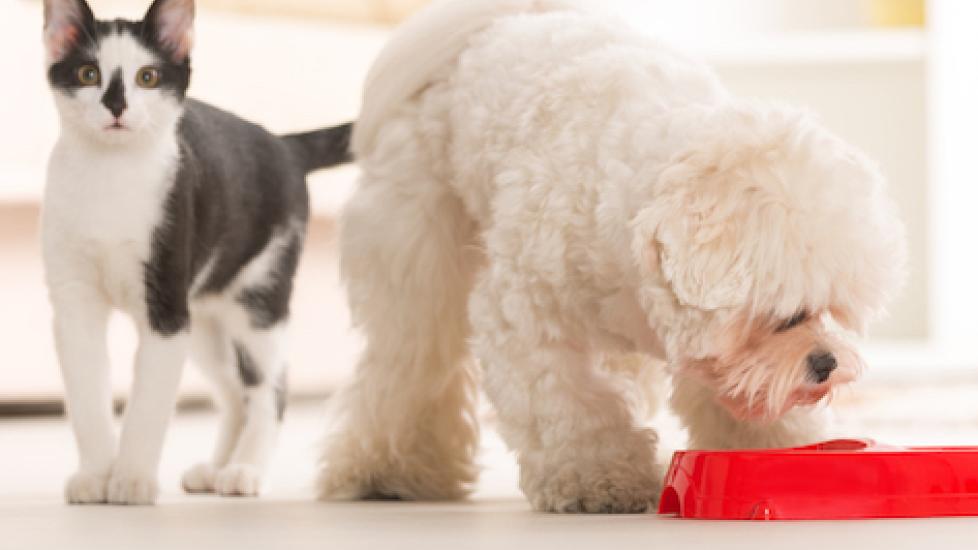Do Pets Know When They Are Full?
I often get asked what, how much, and when to feed dogs and cats. I don’t have a standard answer, because it depends on the specific animal. Some animals can be free-fed and will stop eating when they are full, while others will gain weight with just the occasional table scrap. Similar to people, some of this is genetic and some is environmental.
When to Feed Your Dog or Cat
As for “when” to feed your pet, most healthy adult dogs and cats can have their bowls filled once or twice per day. Whether the animal is required to eat the food all at once or it can sit out is up to you and them. Dogs who are fed meals on a regular schedule will have more predictable potty requirements, which may be important to your lifestyle. But some dogs, and many cats, prefer to nibble throughout the day.
If your adult dog or cat has always been offered meals and eaten them quickly, suddenly switching to unlimited quantities of food (so there is always food in the bowl) will not end well. But if you have a puppy or kitten or are planning to add one to your family, those first few weeks will tell you what kind of eater your new fur baby is. For adult animals, it is easier to switch to meal feeding, but it is possible to try to spread out their food throughout the day. Slow feeder bowls or automatic feeders can help, too.
Of course, you may be in the situation where one dog is a fast eater and the other would slowly graze all day if she could. This definitely complicates things but also gives you an opportunity to be creative. I like the idea of being able to feed each pet in the way they prefer, so long as they are healthy. Maybe putting a bowl up high or under a short table will prevent one or the other pet from getting extra food. Or maybe they just need to be separated for feedings.
When I visit my parents, I have to put my dog’s food upstairs where my parents’ dog can’t get to it. My dog free-feeds while my parents’ dog eats any food immediately. I have clients who put the bowl of dry food in a box with a narrow entrance so that the lean cat can free-feed but the chubby cat on a diet only eats at meal time. There are also tech tools to facilitate differential feeding for pets, such as microchip-activated bowls, if that is your style.
How to Break Bad Eating Habits in Pets
Some dogs and cats only eat when they are hungry. Others will eat whenever there is food. But just as I can be full and still find room for ice cream, a pet always has room for table scraps. I often hear from pet parents that “the dog won’t eat,” so they add chicken or something else delicious to the food as an enticement. That might be necessary for very finicky eaters, but usually the dog or cat who “needs” something special is overweight and isn’t cleaning the bowl because, well, he or she isn’t hungry enough to eat it all. It’s like the idea that if you aren’t hungry enough to eat an apple, you probably aren’t hungry. The same applies for (most) animals—if they aren’t willing to eat their nutritionally balanced dog or cat food, they probably aren’t hungry.
Often, pet parents are reinforcing these bad habits in their animals. Cats and dogs quickly learn that if they wait to eat their food, their humans will add more delicious things to the bowl. They also learn to beg in the kitchen or at the table because it has been reinforced with a reward one or many times in the past. I am not against dogs and cats eating “human food,” so long as it is unprocessed, neither too salty nor too fatty, and only in small amounts. This basically means fruits, vegetables, and bland low-fat meat like boiled chicken or drained ground turkey. But these treats should never be given at the table or in response to begging.
Your pet might protest. Healthy dogs and cats can choose not to eat for a day and there is nothing wrong with them. You can outlast them. If overweight or sick animals don’t eat, that can be a sign that they need to see a veterinarian immediately. Overweight animals, especially cats, should not be deprived of food because this can lead to metabolic problems. But your otherwise healthy, chubby dog can protest by not eating for at least a full day. Do not give in. Lean dogs live longer, healthier lives and are more comfortable in their older years.
Remember, the little extras add up. Your dog or cat probably knows when she is full. Don’t help her pack on the pounds by giving extras.
Dr. Elfenbein is a veterinarian and animal behaviorist located in Atlanta. Her mission is to provide pet parents with the information they need to have happy, and healthy, and fulfilled relationships with their dogs and cats.
